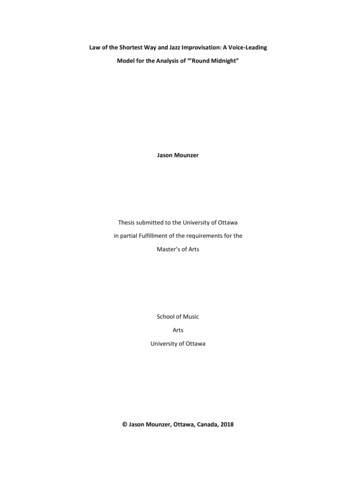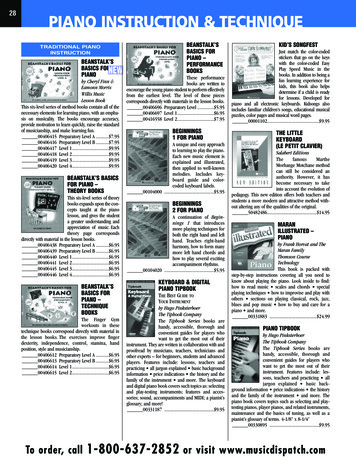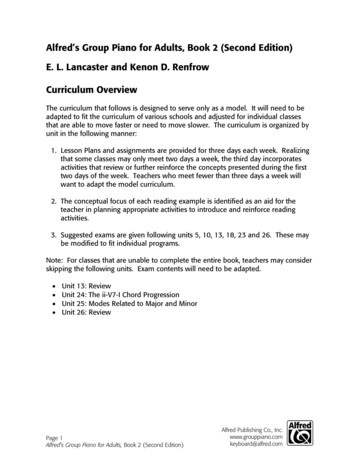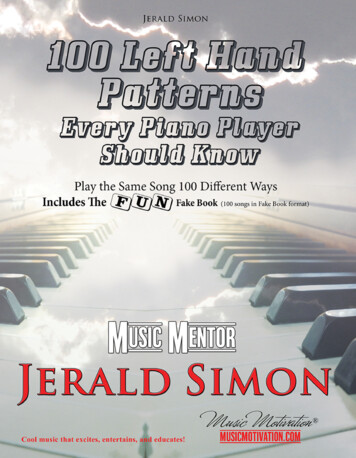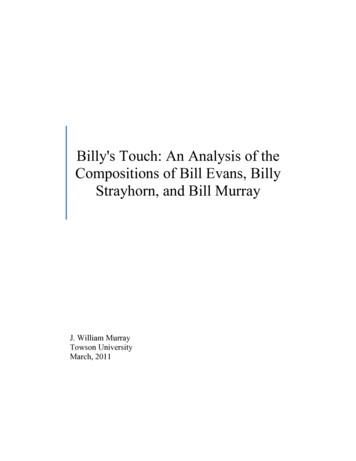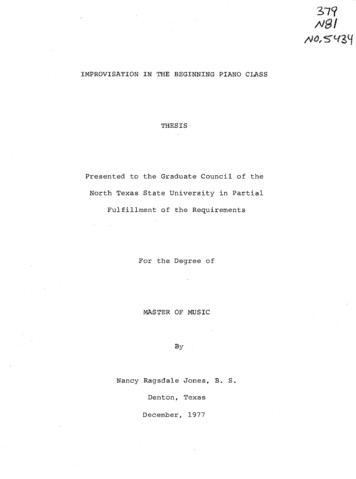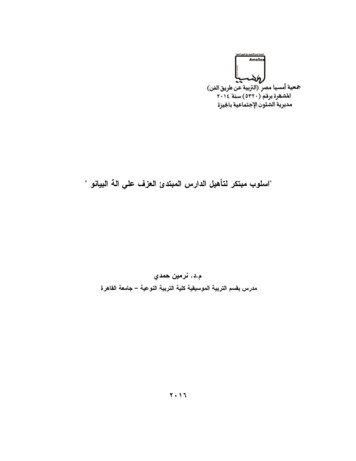
Transcription
http://www.musilosophy.com(Piano) ImprovisationTechniqueby Musilosophywww.musilosophy.comImprovisation means real time composing.Copyright 2006 Paolo Parrella.All rights reserved.1
http://www.musilosophy.com“I know of knowing nothing” ( Socrates )Music is based on harmonyHarmony is based on chords and scalesMelody and improvisation are based on chords and scalesAccompaniment is based on chords and scalesChords are based on scalesScales are based on physics,mathematical principles and musicaltradictionsMusical tradictions are based on n Copyright 2006 Paolo Parrella.All rights reserved.2
http://www.musilosophy.comSUMMARY1. KeysKey awarenessMajorMinorScale harmonization2.ChordsMajor 7thMinor 7thDominant 7thHalf diminished 7thDiminished 7thInversionsChord degrees3.Other scalesBluesWhole toneDiminishedDiminished/whole tonePentatonicCopyright 2006 Paolo Parrella.All rights reserved.3
http://www.musilosophy.com4.MelodyMelody buildingChordal notesTurning notePassing noteLeaning noteDelaying noteAnticipated noteChromatic noteDouble leaning noteMixed note“Wrong” notes5.PhrasingBeginning of phraseEnding of phraseImitation6.RhythmEmphasizing offbeats and upbeatsSyncopationSwingPolyrhythmics7.Practice Practice Practice Generale practiceProgressive drillsFondamental drillsGreatest piano improviseCopyright 2006 Paolo Parrella.All rights reserved.4
http://www.musilosophy.com5KEY AWARENESSScale is a sequence of tones.It is a base to make music.The main scales of western music are major and minor scales.Every scale determines a key,that is an harmonic combunation of tonesbased on that scale.So, F Major key uses the tones of F Major scale.E minor key uses the tonesof E minor scale(s).I consider the Blues like a key: for example Bb Blues or Bb minor Bluescan be considered two kind of Major and Minor keysYou always have to know in which key you are playing in each moment.A change of key is called Modulation.Each scale or key has its own chords.They are build on each degree of the scale with harmonizations by thirdsYou can recognize key by Clef,chords,melody Transpose and play in all keys!The chords of every key are:Major Key : D Maj ExampleCopyright 2006 Paolo Parrella.All rights reserved.
http://www.musilosophy.comHarmonic Minor Key : D minor exampleNatural Minor Key : D minor exampleMelodic Minor Key : D minor exampleTranspose and play in all keys!Practice the analysis and recognition of chords, modulations and keys inclassic music,jazz,pop songs Recognize the chords and then the key they belong to.Copyright 2006 Paolo Parrella.All rights reserved.6
http://www.musilosophy.com7! Remember:Each chord has not an its own scale.The scale of each chord depends by the key in which it is!This concept is very important but I have realized that not many musicians haveunderstood its importance.For example, they play the D dorian scale also on a Dmin7 that belongs to Bbkey!Ahi,Ahi in this way they do two terrible mistakes: E instead of Eb and B insteadof Bb!Copyright 2006 Paolo Parrella.All rights reserved.
http://www.musilosophy.comWhen you improvise on this song you have to use basically the C minor scale(when you are in C minor key) and Eb scale when you are in Eb key.This is the key concept.But a melody and so an improvisation is based above allon chord besides on key.Copyright 2006 Paolo Parrella.All rights reserved.8
http://www.musilosophy.comCopyright 2006 Paolo Parrella.All rights reserved.9
http://www.musilosophy.comCopyright 2006 Paolo Parrella.All rights reserved.10
http://www.musilosophy.comCopyright 2006 Paolo Parrella.All rights reserved.11
http://www.musilosophy.comCopyright 2006 Paolo Parrella.All rights reserved.12
http://www.musilosophy.comCopyright 2006 Paolo Parrella.All rights reserved.13
http://www.musilosophy.comCopyright 2006 Paolo Parrella.All rights reserved.14
http://www.musilosophy.comCopyright 2006 Paolo Parrella.All rights reserved.15
http://www.musilosophy.comCopyright 2006 Paolo Parrella.All rights reserved.16
http://www.musilosophy.comChord familiesEvery melody and accompaniment is based on a chord.Melody generally uses the notes of a chord or notes that return to it.In order to improvise you need to know and play every chord very well.The fondamental drill is playing every chord and every inversion of eachchord.I suggest to study five families of chords:1.2.3.4.5.Major 7th chordDominant 7thMinor 7thHalf-diminishedDiminished 7thPlay every chord :12 chords X 5 families 60 chords X 4 inversions 240 chordsFor example:1. Major 7th chord : F Maj 7 Maj 3th perfect 5th maj 7thCopyright 2006 Paolo Parrella.All rights reserved.17
http://www.musilosophy.com2. Dominant 7th chord : Bb 7 Maj 3th perfect 5th minor 7th3. Minor 7th chord : Em7 Minor 3th perfect 5th minor 7th4. Minor 7th dim 5 (half-diminished) chord : Dm7b5 Minor 3th diminished 5th minor 7th5. Diminished 7th chord : C# dim7 Minor 3th diminished 5th diminished 7thCopyright 2006 Paolo Parrella.All rights reserved.18
http://www.musilosophy.comMajor 7th chordThis chord is on the :I and IV (#4)degree of the Major keyIII (#5)degree of the harmonic and melodic minor keyIII and VI (#4) degree of the natural minor key.! #4 This chord has augmented 4th#5 This chord has augmented 5thIn the next page there are major chords in all keys and in 4 inversionsPLAY them many,many times!It is very important.Play these chords in the whole keyboard (More than an octave)Play them with both handsArpeggiate the chordsCopyright 2006 Paolo Parrella.All rights reserved.19
http://www.musilosophy.comCopyright 2006 Paolo Parrella.All rights reserved.20
http://www.musilosophy.comCopyright 2006 Paolo Parrella.All rights reserved.21
http://www.musilosophy.comDominant 7th chordThis chord is on the :V and degree of the Major and harmonic/melodic minor (b9 and b6) keyVII degree of the natural minor keyIV (#4) degree of the melodic minor key.! #4 This chord has augmented 4thb6 This chord has minor 6thb9 This chord has minor 9thIn the next page there are dominant 7th chords in all keys and in 4 inversionsPLAY them many,many times!It is very important.Play these chords in the whole keyboard (More than an octave)Play them with both handsArpeggiate the chordsCopyright 2006 Paolo Parrella.All rights reserved.22
http://www.musilosophy.comCopyright 2006 Paolo Parrella.All rights reserved.23
http://www.musilosophy.comCopyright 2006 Paolo Parrella.All rights reserved.24
http://www.musilosophy.comMinor 7th chordThis chord is on the :II,III, and VI degree of the Major keyI,IV and V degree of the natural minor keyII degree of the melodic minor key.IV degree of the harmonic minor keyIn the next page there are minor 7th chords in all keys and in 4 inversionsPLAY them many,many times!It is very important.Play these chords in the whole keyboard (More than an octave)Play them with both handsArpeggiate the chordsCopyright 2006 Paolo Parrella.All rights reserved.25
http://www.musilosophy.comCopyright 2006 Paolo Parrella.All rights reserved.26
http://www.musilosophy.comCopyright 2006 Paolo Parrella.All rights reserved.27
http://www.musilosophy.comHalf Diminished chord! It is also called minor 7th dimished 5 (b5) chord( C m7/b5 )This chord is on the :VII degree of the Major keyII degree of the natural and harmonic minor keyVI and VII degree of the melodic minor key.In the next page there are half diminished chords in all keys and in 4 inversionsPLAY them many,many times!It is very important.Play these chords in the whole keyboard (More than an octave)Play them with both handsArpeggiate the chordsCopyright 2006 Paolo Parrella.All rights reserved.28
http://www.musilosophy.comCopyright 2006 Paolo Parrella.All rights reserved.29
http://www.musilosophy.comCopyright 2006 Paolo Parrella.All rights reserved.30
http://www.musilosophy.comDiminished 7th chordThis chord is on the :VII degree of the harmonic minor keyIn the next page there are diminished 7th chords in all keys and in 4 inversionsPLAY them many,many times!It is very important.Play these chords in the whole keyboard (More than an octave)Play them with both handsArpeggiate the chordsCopyright 2006 Paolo Parrella.All rights reserved.31
http://www.musilosophy.comCopyright 2006 Paolo Parrella.All rights reserved.32
http://www.musilosophy.comCopyright 2006 Paolo Parrella.All rights reserved.33
http://www.musilosophy.com34Blues,Whole tone,Diminished,Diminished/Wholetone,Pentatonic scalesOk, do not become confused!These scales do not determine a key !Just the blues scale can beconsidered a basis for a particular key (Blues).Blues ScaleIn general it can be used on every chord but above all on min7 th anddominant 7th chord.This scale is much used above all inBlues,Pop,Jazz,Soul,Funk,Rhythm and blues,Rock .Copyright 2006 Paolo Parrella.All rights reserved.
http://www.musilosophy.comBlues structure It has 12 or , seldom, 16 measures. It can be Major or Minor There are many chord variations or substitutions in Bluesstructures.Here I propose two “classic” blues/jazz structures.! Traspose and play the blues scales and structures in all keys.Copyright 2006 Paolo Parrella.All rights reserved.35
http://www.musilosophy.comCopyright 2006 Paolo Parrella.All rights reserved.36
http://www.musilosophy.comCopyright 2006 Paolo Parrella.All rights reserved.37
http://www.musilosophy.comCopyright 2006 Paolo Parrella.All rights reserved.38
http://www.musilosophy.comCopyright 2006 Paolo Parrella.All rights reserved.39
http://www.musilosophy.comCopyright 2006 Paolo Parrella.All rights reserved.40
http://www.musilosophy.comCopyright 2006 Paolo Parrella.All rights reserved.41
http://www.musilosophy.comCopyright 2006 Paolo Parrella.All rights reserved.42
http://www.musilosophy.comCopyright 2006 Paolo Parrella.All rights reserved.43
http://www.musilosophy.comCopyright 2006 Paolo Parrella.All rights reserved.44
http://www.musilosophy.comCopyright 2006 Paolo Parrella.All rights reserved.45
http://www.musilosophy.com46Whole tone – It is made only by whole tones.I suggest to use it just on thedominant 7th chord.Whole tone scale is used above all in Jazz music.We can simplify and summarize all 12 whole tone scales to just 2 scale types : “A”whole tone scale and “B” whole tone scale.“A” whole tone scale type“B” whole tone scale type The other 10 whole tone scales have the same notes of these,but, ofcourse, they begin from different tones.For example, D whole tone scale begins from D and has the same notes of the“A” whole tone scale, while F whole tone scale begins from F and has thesame notes of the “B” whole tone scale.Copyright 2006 Paolo Parrella.All rights reserved.
http://www.musilosophy.com47Diminished Scale – It is made only by a sequence of half step (semitone)and whole step (tone).I suggest to use it just on the dominant 7th and diminished 7thchord in a jazz context.Diminished scale is used above all in Jazz music. Each tone has two different Diminished scale:1. Diminished scale beginning with half step2. Diminished scale beginning with whole stepFor example : C dim scale beginning with half step (“A” type),and C dim scale beginning with whole step (“B” type)Moreover,we can simplify and summarize all 12 diminished scales to just 3 scale types : “A”diminished scale, “B” diminished scale and “C” diminished scale“A” diminished scale type“B” diminished scale typeCopyright 2006 Paolo Parrella.All rights reserved.
http://www.musilosophy.com“C” diminished scale type The other 21 diminished scales have the same notes of these,but, ofcourse, they begin from different tones.Copyright 2006 Paolo Parrella.All rights reserved.48
http://www.musilosophy.com49Diminished/whole tone scale ( also called Super Locrian or AlteredScale) and whole step (tone).I suggest to use it just on the dominant 7th anddiminished 7th chord in a jazz context.Diminished scale is used above all in Jazzmusic.Copyright 2006 Paolo Parrella.All rights reserved.
http://www.musilosophy.comCopyright 2006 Paolo Parrella.All rights reserved.50
http://www.musilosophy.comCopyright 2006 Paolo Parrella.All rights reserved.51
http://www.musilosophy.com52Pentatonic scale has just five tones.It is like the Major scale but without4th and 7th degrees.This a very catchy scale and it sounds good on many chords(Maj 7th , min 7th , 7th )You can use different pentatonic scales on a chord.Copyright 2006 Paolo Parrella.All rights reserved.
http://www.musilosophy.comMelody buildingMelody is the most powerful and beautiful item of music.It hassymmetric,geometric and harmonic rules:! Pay Attention: I mean1th , 3th, 5th and 7th by “CHORDAL NOTE”When you improvise or compose, you can use to build a melody these notes:1. Notes of the chord - (Chordal note)( chordal note)You can use the notes of a chord freelyCopyright 2006 Paolo Parrella.All rights reserved.53
http://www.musilosophy.com2. Turning note : does not belong to chord but comes from a note of thechord and turn on it. ( T Turning note)You have to turn on the note of the chord3. Passing note : it is between two chordal notes. ( P Passing note)Copyright 2006 Paolo Parrella.All rights reserved.54
http://www.musilosophy.com554. Leaning note (Appoggiatura) : it leans on a chordal note ( L Leaningnote)After a leaning note you have to play the chordal note close to it5. Delaying note (Ritardo) : it delays a chordal note ( D Delaying note)After a delaying note you have to play the straight away below chordal noteCopyright 2006 Paolo Parrella.All rights reserved.
http://www.musilosophy.com56The difference between leaning and delaying note is that
course, they begin from different tones. For example, D whole tone scale begins from D and has the same notes of the “A” whole tone scale, while F whole tone scale begins from F and has theFile Size: 2MBPage Count: 78
